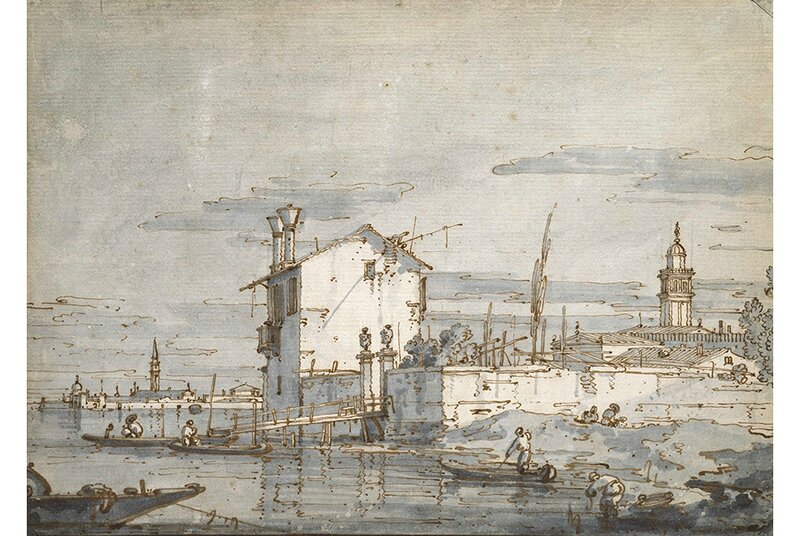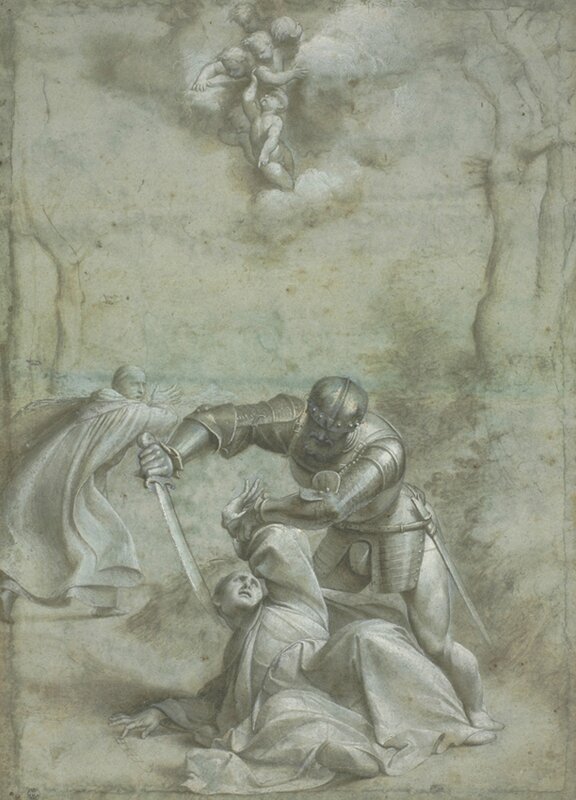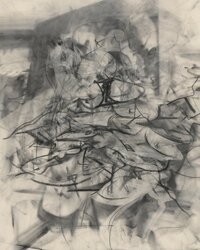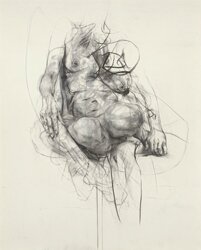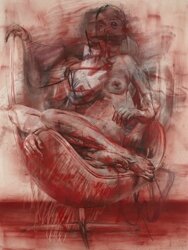Andrea Vaccaro, Saint Sebastian, 17th century
Alessandro Varotari (Il Padovanino), San Sebastiano, 17th century
Sigismondo Coccapani, Saint Sebastian, 17th century
Francesco Guarino, Saint Sebastian, 17th century
Francesco Cairo, Saint Sebastian, 17th century
Coco Chanel
Sotheby’s France met en vente un ensemble exceptionnel d’objets archaïques chinois de la collection David David-Weill
A bronze taotie mask fitting, Early Western Zhou Dynasty. Estimate 30.000-50.000 €. hoto: Sotheby’s / Art Digital Studio.
PARIS.- Sotheby's est heureuse d’annoncer la vente de la collection David David-Weill de trésors de la Chine ancienne le 16 décembre à Paris. Comprenant une soixantaine d’objets collectés durant la première moitié du XXe siècle, cette collection extraordinaire est un des ensembles d’art archaïque chinois les plus fascinants àêtre offert sur le marché ces dernières années.
David David-Weill (1871-1952) est issu d’une célèbre famille de banquiers. Sa famille rentre en France en 1884 profitant du voyage pour visiter tous les grands musées européens. Voyage initiatique pour l’adolescent David David-Weill, qui se découvrit une passion dévorante pour l’art. Eclectique, il collectionnera toute sa vie les tableaux anciens, la sculpture, les antiquités aussi bien que le mobilier du XVIIIe siècle…
David David-Weill fait figure de visionnaire dans de nombreux domaines : il commence à s’intéresser à l’art chinois à une époque où cette esthétique nouvelle n’a encore que peu d’adeptes en Occident. Avec son insatiable curiosité et son oeil aiguisé exercéà reconnaître la qualité et la rareté, il forme une des plus importantes collections d’art archaïque chinois en France. Surnomméà juste titre « la providence » des musées français, on ne compte plus le nombre d’oeuvres dont il fit don au Louvre, au musée Guimet ou encore celui des Arts décoratifs ou dont il soutint l’acquisition.
David David-Weill s’intéressait à l’art chinois en général. Sa vaste collection comprenait des céramiques Song, des sculptures bouddhiques aussi bien que des peintures classiques. Ce sont toutefois les jades et bronzes archaïques qui eurent rapidement sa faveur. Il les acquiert à l’époque où les objets issus des premières fouilles archéologiques en Chine commencent à se frayer un chemin vers les collections occidentales les plus prestigieuses, grâce à des marchands influents.
Entre les deux guerres, un petit cercle fermé de collectionneurs, marchands et universitaires, formèrent en Europe certaines des plus importantes collections privées et institutionnelles d’art chinois hors de Chine.
David David-Weill prêta à plusieurs reprises des pièces lors des premières expositions sur l’art chinois à travers l’Europe. Nombreux sont les jades et bronzes archaïques de sa collection montrés et publiés à Paris dans les années 1930. Sur la scène internationale, son nom figure parmi les plus grands collectionneurs d’art chinois de son temps, tels Adolphe Stoclet, George Eumorfopoulos, Oscar Raphaël ou le roi Gustave Adolphe de Suède.
Les Trésors de la Chine Ancienne de la Collection David David-Weill offrent un remarquable aperçu de la richesse de l’univers décoratif et culturel de l’art archaïque chinois. Cet exceptionnel ensemble est une occasion unique pour les collectionneurs d’acquérir des pièces rarissimes, de qualité muséale et auréolées d’une provenance historique prestigieuse.
A rare large archaic bronze ritual food vessel. Ding. late Shang Dynasty. Anyang phase, ca. 1200 BC. Estimate: 150.000/250.000 €. Photo: Sotheby’s / Art Digital Studio.
Ce grand récipient rituel en bronze, Liding, ca. 1200 BC, était à l’origine placé dans la tombe d’un haut dignitaire de la dynastie Shang. Rempli d’offrandes, mets délicats et vins précieux, ces bronzes rituels faisaient partie intégrante de l’aménagement d’une sépulture aristocratique et témoignait de l’importance social du défunt. Notre récipient est très important par sa taille imposante, son décor très particulier et le pictogramme unique à l’intérieur.
En comptant celui-ci on connaît désormais trois récipients de la même taille, de la même forme et présentant le même décor, ils faisaient originellement partie du même ensemble. Acquis par David David-Weill en 1935 à E. Gutmann, célèbre collectionneur d’art archaïque chinois baséà Paris, il est probablement issu des tombes d’Anyang au Henan, sur le site de l’ancienne capitale des Shang, Yinxu (Estimation : 150.000/250.000 €).
A very rare and important double side-faced staff finial, Early Western Zhou dynasty, ca. 11th-10th century BC. Estimate 50.000/70.000 €. Photo: Sotheby’s / Art Digital Studio.
Cette rare terminaison biface, début de la dynastie des Zhou occidentaux, XIe-Xe siècle avant J.-C., servait à renforcer et à décorer l’extrémité d’une barre. Les terminaisons en bronze font partie intégrante du répertoire décoratif utilisé par les Zhou pour embellir leurs chars et le harnachement des chevaux. Utilisés en temps de guerre, ces ornements étaient également des marqueurs sociaux pour la noblesse Zhou et accompagnaient souvent ses membres dans l’au-delà. Cette terminaison de la collection David David-Weill est très inhabituelle car elle représente de façon extrêmement naturaliste un visage humain au nez et aux yeux proéminents et une large bouche souriante. Ce décor est pratiquement inusité sur les récipients rituels en bronze d’époque Shang et Zhou et rarement utilisé sur des ornements de chars ou de chevaux.
Seules trois terminaisons en bronze similaires sont connues dans des collections privées et institutionnelles en Europe et aux Etats-Unis. Elles furent toutes acquises à la même époque, dans les années 1930, l’une est issue de la Collection Eumorfopoulos et est désormais conservée au British Museum à Londres (Estimation 50.000/70.000 €).
An impressive bronze taotie mask, Early Western Zhou Dynasty, ca. 11th century BC, Estimate 50.000/70.000 €. Photo: Sotheby’s / Art Digital Studio.
Ces prodigieux masques de Taotie en bronze, début de la dynastie des Zhou occidentaux, ca. XIe siècle avant J.-C comptaient parmi les ornements protecteurs et décoratifs utilisés sur les chars et le harnachement des chevaux. Marqueurs sociaux importants dans la culture Zhou, ils accompagnaient souvent les défunts dans l’au-delà. On retrouve plusieurs exemples de masques en bronze dans la collection David David-Weill. Celui-ci est le plus imposant et le plus expressif. Moulé en plusieurs morceaux, il représente un Taotie, motif incontournable du répertoire décoratif sous les Shang et les Zhou. Il réapparait régulièrement sur les bronzes de la collection David David-Weill, notamment sur le grand récipient rituel tripode, Liding (Estimation : 50.000/70.000 €).
A very rare and important large jade notched disc, xuanji, late Neolithic Period to Shang Dynasty, ca 2000-1200 BC. Estimate 80.000/120.000 €. Photo: Sotheby’s / Art Digital Studio.
Ce disque cranté en jade, Epoque néolithique, ca 2000 avant J.-C, exceptionnel par sa taille, appartient à une petite catégorie de jades archaïques encore méconnus. Bien que leur forme reprenne celle des disques bi bien connus à l’ouverture centrale circulaire, les disques crantés se distinguent par les profondes entailles qui segmentent le pourtour. Les disques crantés apparaissent dès la fin de l’époque néolithique à l’est de la Chine dans la province de Shandong et à l’ouest dans celle de Shaanxi et survivent jusqu’à la fin de l’époque Shang. De rares exemples subsistent, découverts dans des tombes très importantes, démontrant la valeur intrinsèque de ces objets aux yeux de leurs propriétaires. On connait peu de disques crantés en dehors de Chine, la plupart collectés également dans les années 1930. Ils se trouvent désormais dans des musées comme le Fogg Museum à Harvard ou l’Art Institute de Chicago (Estimation 80.000/120.000 €).
Extrêmement bien sculptée et polie, cette lame cérémonielle en jade, époque néolithique, ca 2000-1000 avant J.-C, combine la forme d’un couteau et celle d’un sceptre. Il s’agit d’une des rares lames archaïques qui tire sa forme des prototypes en pierre. Comme le grand disque cranté de la collection David David-Weill, on retrouve ce type de lames dans deux principales régions éloignées géographiquement l’une de l’autre : le Shaanxi et le Shandong où une multitude de lames de ce type furent découvertes au début des années 1920. Quelques exemples sont arrivés dans les collections occidentales peu après et sont désormais conservés dans des musées en Europe et aux Etats-Unis. Cette grande lame cérémonielle a été publiée pour la première fois par Paul Pelliot en 1925 puis acquise par David David-Weill chez le célèbre marchand C.T. Loo à Paris (Estimation : 80.000/120.000 €).
Large dark green jade disc, Bi, early Western Han period (206 BC-220 AD). Estimate 30.000/50.000 €. Photo: Sotheby’s / Art Digital Studio.
Les premiers disques Bi en jade vert foncé apparurent au début de la période des Han de l’ouest, 206 av. J.-C. - 220. Malgré son aspect brut, ce bel exemple, IIe/Ie siècle avant J.-C, est très habilement sculpté d’une frise de masques à cornes entrelacés entourant des volutes facettées en relief, un décor inspiré des décors ajourés qu’on retrouvait antérieurement dans le travail du métal. On retrouve des disques arborant ce type de décor dans de nombreuses tombes de dignitaires des Han de l’Ouest, à l’intérieur et autour des sarcophages. Ce qui laisse penser que ces défunts, dans leurs linceuls de jade, devaient leur prêter des vertus protectrices. Comme d’autres disques du même type conservés désormais dans des musées, cet exemple issu de la collection David David-Weill a été acquis dans les années 1930 à l’époque où de nombreux objets similaires arrivaient sur le marché de l’art occidental (Estimation : 30.000/50.000 €).
A rare cast bronze fitting in the form of a tiger, Eastern Zhou Dynasty, Warring States period. Estimate 20.000-30.000 €. Photo: Sotheby’s / Art Digital Studio.
PARIS.- Sotheby's announced that the collection of David David-Weill will be sold in Paris on 16 December 2015. An exceptional collection of approximately 60 early Chinese works of art formed in the first half of the 20th century by David David-Weill (1871-1952) is the one of the most significant groups of early Chinese art to come to market in recent years with a variety of objects dating from the Neolithic to the early dynastic periods of Chinese history.
David David-Weill was born in San Francisco in 1871 to a prominent family of French bankers. It was after the family returned to France in 1884 and during an extended tour of European museums that David David-Weill developed what was to become a life-long passion for the arts, encompassing among other things old master paintings, sculpture, antiquities and 18th century French furniture. He was in many ways a true visionary who began collecting Chinese art long before its aesthetics became known to a wider audience in the West. With a discerning eye for quality and rarity and with a tremendous curiosity about the objects he acquired, he formed one of the most important collections of early Chinese art in France. During his lifetime he donated many pieces to the Musee Guimet, the Louvre and the Musee des Arts Decoratifs in Paris while also supporting the acquisition of other important works of art for these museums.
David David-Weill had a wide range of interest in the arts of China. His vast collection encompassed Song ceramics, Buddhist sculpture as well as classical paintings. Yet the focus of his Chinese collection lay on archaic jades and bronzes. He acquired many of the objects in his collection at a time when great works first appeared on the international art market. Fuelled by archaeological discoveries in China and promoted by several influential dealers, Chinese art attracted the interest of celebrated connoisseurs. In the period between the two wars, a close-knit circle of collectors, dealers and academics in Europe formed some of the most important private and museum collections of early Chinese art outside of China. A series of ground-breaking exhibitions on Chinese art in Paris and London brought together collectors and their collections. David David-Weill loaned objects from his collection around Europe and many of the archaic bronzes and jades in his collection were published and exhibited in Paris in the 1930s. Internationally, his name featured prominently alongside other celebrated collectors of early Chinese art including Adolphe Stoclet, George Eurmorfopoulos, Oscar Raphael and King Gustav Adolf of Sweden.
Treasures of Ancient China from the David David-Weill Collection offers a glimpse into the richness of the visual and functional vocabulary of early Chinese art. It offers collectors the rare opportunity to enrich their collections with pieces of museum quality and with a highly distinguished provenance.
Highlights of the David David-Weill Collection
A rare large archaic bronze ritual food vessel. Ding. late Shang Dynasty. Anyang phase, ca. 1200 BC. Estimate: 150.000/250.000 €. Photo: Sotheby’s / Art Digital Studio.
A magnificent bronze ritual vessel, Liding Late Shang Dynasty, ca. 1200 BC, is notable for its impressive size, distinctive design and the single pictogram on the interior. It is one of three known vessels of the same size, shape and design that originally formed part of the same set. Acquired by David-Weill in 1935 from E. Gutmann, a fellow collector of archaic bronzes based in Paris, it was reputedly excavated near Anyang in Henan province, site of the ancient capital of Yinxu of the late Shang rulers (Est. :€150,000/250,000).
A very rare and important double side-faced staff finial, Early Western Zhou dynasty, ca. 11th-10th century BC. Estimate 50.000/70.000 €. Photo: Sotheby’s / Art Digital Studio.
A rare bi-faced bronze finial, Early Western Zhou dynasty, 11th/10th century BC, is highly unusual as it is decorated with a naturalistically modelled human face on one side. It is one of only four similarly decorated finials known in public and private collections in Europe and the US that were collected at the same time in the 1930s (Est.: € 50,000/70,000).
An impressive bronze taotie mask, Early Western Zhou Dynasty, ca. 11th century BC, Estimate 50.000/70.000 €. Photo: Sotheby’s / Art Digital Studio.
An impressive Bronze masks such as this impressive example, Early Western Zhou Dynasty, ca. 11th century BC, is one of several bronze masks in the David-Weill collection. It is also the largest and most expressive (Est.: € 50,000/70,000)
A very rare and important large jade notched disc, xuanji, late Neolithic Period to Shang Dynasty, ca 2000-1200 BC. Estimate 80.000/120.000 €. Photo: Sotheby’s / Art Digital Studio.
An exceptionally large jade disc, Xuanji, Neolithic Period, ca 2000 BC, belongs to a small and still little understood category of early jades. Few jade notched discs are known outside of China. Most of these examples were collected in the west as early as the 1930s and are now held in museum collections such as in the Fogg Museum in Harvard or the Art Institute in Chicago (Est.: € 80,000/120,000).
Kim Jung-Man au musée Cernuschi
Kim Jungman, Pillars of East, 260 cm X 468 cm, Zhangjiajie, China, 2013.
KIM JUNG-MAN 김중만, 金重晩. Né en 1954 à Ch'ŏrwŏn (Cheorwon)
La jeunesse de Kim Jung-Man est marquée très tôt par le dépaysement et un déplacement du regard. Adolescent, il suit en effet son père médecin jusque dans les banlieues rurales du Burkina Faso. Dans cette ancienne colonie française, il commence à apprendre en autodidacte la langue de Molière, ce qui lui permet peu après de rejoindre l'Hexagone. Il étudie la peinture à l'Ecole nationale supérieure des arts décoratifs de Nice entre 1974 et 1977. C'est pendant ce cursus qu'il découvre et commence également à pratiquer la photographie. Cette technique devient dès lors sa forme d'expression privilégiée et lui vaut une reconnaissance presque immédiate. Il remporte ainsi en 1979, lors de sa participation aux rencontres internationales de la photographie d'Arles, un prix récompensant les jeunes talents.
La carrière de photographe de Kim Jung-Man est marquée depuis par l'errance et a conduit cet artiste à parcourir tous les continents à la recherche de ses sujets. L'Afrique, à laquelle le lient sa jeunesse, mais aussi l'espoir paternel de voir ses créations servir ce continent, a notamment retenu régulièrement son attention, qu'il s'agisse de produire des clichés d'animaux sauvages, d'immortaliser des paysages ou d'organiser des opérations humanitaires.
Toutefois, c'est en Corée, où il revient s'installer en 1988, qu'il réalise l'essentiel du travail qui le rend célèbre et incontournable dans le domaine de la photographie commerciale et de la photographie de mode. Il devient rapidement le portraitiste privilégié des grandes célébrités issues des industries culturelles de la péninsule. Sa maîtrise des compositions, son goût du détail, son appétence pour les poses sobres ainsi que pour l'emploi privilégié d'un noir et blanc chaleureux et élégant mettent ainsi en valeur plusieurs générations de chanteurs et d'acteurs.
En 2006, Kim Jung-Man rompt avec cette situation confortable et réoriente radicalement sa carrière pour la consacrer à une production artistique déconnectée du système de commandes dans lequel lui et son atelier, le Velvet Underground Studio, évoluent. Ce virage professionnel s'accompagne de la volonté nouvelle d'explorer une identité coréenne et asiatique, que ce soit sur le plan technique, par exemple par le tirage des clichés sur papier de mûrier hanji, ou thématique. En témoignent de manière particulièrement forte la série deshanbok et celle intitulée East.
Lors d'une séance de photographie de mode, Kim Jung-Man découvre l'attrait qui se dégage de ses modèles vêtues d'un habit féminin traditionnel (hanbok). Cette révélation de la beauté, qui fut celle de générations de femmes, de mères et de grand-mères coréennes, le bouleverse. Il s'emploie dès lors à magnifier la dimension esthétique et poétique de cette tenue, mais aussi à en explorer la sensualité, et parfois l'érotisme. Ce travail s'inscrit délibérément dans la continuation et l'exploration d'un passé autochtone, comme le soulignent parfois l'emploi de tons sépia et les références récurrentes aux peintures volontiers licencieuses de Sin Yunbok 신윤복, 申潤福 (vers 1758-après 1813).
Les panoramas de East, monumentaux par leur taille et leur style, constituent, quant à eux, un travail centré sur la définition d'un paysage extrême-oriental. Celle-ci passe pour partie par l'immortalisation de multiples lieux majeurs d'une culture géographique, spirituelle et esthétique largement partagée dans cette région du monde. Elle est enrichie par la réinterprétation de la tradition picturale chinoise, japonaise et coréenne. Kim Jung-Man, ancien peintre, parvient en effet à superposer à la réalité physique des lieux photographiés les strates successives de leurs interprétations plastiques et à inscrire ainsi ses sujets dans la lignée d'une tradition artistique dont il est, parmi d'autres, l'héritier.
Kim Jungman, Pilgrim Yellow Mountain, 260 cm X 468 cm, China, 2014.
«HANBOK»
Kim Jungman travaille sur cette série depuis plus de dix ans. C'est en plein shooting pour la maison Chanel avec des mannequins vêtus de hanboks, qu'il prend conscience que ce vêtement traditionnel constitue la véritable image de la Corée. Sous la dynastie Lee (1392-1910), les rois coréens ont imposé un confucianisme drastique.
Chacune des classes de la société coréenne était reconnaissable par sa façon de porter le hanbok traditionnel, notamment à l'occasion des mariages et des funérailles. Au-delà de la photographie de mode, Kim Jungman explore, la complexité et la diversité de ce costume traditionnel en le confrontant au monde contemporain et en immergeant le spectateur dans l'histoire de la Corée.
jusqu'au 18 octobre 2015
Kim Jungman, Costume of Wind, 184cm x 128cm, 1996
Kim Jungman, Promenade, 184cm x 140cm, 2014
Kim Jungman, Les Femmes de Shin Yunbok III, 184cm x120cm, 2014
Kim Jungman, Mademoiselle Yukyung, 180cm x 135cm, 2011
A diamond ring, by Van Cleef & Arpels and a sapphire and diamond ring
A 6.46 carats Type IIa diamond ring, by Van Cleef & Arpels (Estimate $350,000 – $450,000) and A 20.97 carats Burma sapphire and diamond ring Estimate $150,000 – $200,000. Photo Christie's Image Ltd 2015
A 6.46 carats Type IIa diamond ring, by Van Cleef & Arpels. Estimate $350,000 – $450,000. Photo Christie's Image Ltd 2015
Set with an oval brilliant-cut diamond, weighing approximately 6.46 carats, flanked on either side by a pear-shaped diamond, ring size 6 1/2, mounted in platinum. Signed Van Cleef & Arpels, no. M 41139
Accompanied by report no. 17438638 dated 12 August 2015 from the GIA Gemological Institute of America stating that the diamond is D color, Internally Flawless clarity
With a supplemental letter from the Gemological Institute of America stating that the diamond has been determined to be a Type IIa diamond. Type IIa diamonds are the most chemically pure type of diamond and often have exceptional optical transparency. Type IIa diamonds were first identified as originating from India (particularly from the Golconda region) but have since been recovered in all major diamond-producing regions of the world. Among famous gem diamonds, the 530.20 carat Cullinan I and the 105.60 carat Koh-i-noor, are examples of Type IIa
A 20.97 carats Burma sapphire and diamond ring. Estimate $150,000 – $200,000. Photo Christie's Image Ltd 2015
Set with a cushion-cut sapphire, weighing approximately 20.97 carats, to the circular-cut diamond surround and half hoop, ring size 6, mounted in platinum
Accompanied by report no. 11060146 dated 21 June 2011 from the Gübelin GemLab stating that it is the opinion of the Laboratory that the origin of this sapphire would be classified as Burma (Myanmar), with no indications of heating
Christie's. IMPORTANT JEWELS, 20 October 2015, New York, Rockefeller Plaza
A pair of sapphire and diamond ear pendants, by David Webb
A pair of Burma and Ceylon sapphire and diamond ear pendants, by David Webb. Estimate $125,000 – $170,000.Photo Christie's Image Ltd 2015
Each suspending a detachable circular-cut diamond and graduated sapphire bead triple tassel, to the surmount set with an oval-cut cabochon sapphire, weighing approximately 30.43 and 28.42 carats, within a two-row circular-cut diamond surround, 3 1/2 ins., mounted in platinum and 18k white gold. Signed Webb for David Webb
With Certificate of Authenticity from David Webb
Accompanied by report no. CS 62867 A dated 5 September 2014 from the AGL American Gemological Laboratoriesstating that it is the opinion of the Laboratory that the origin of the sapphire weighing 30.43 carats would be classified as Burma (Myanmar). Heat enhancement: None. Clarity enhancement: None
With report no. CS 62867 B dated 5 September 2014 from the AGL American Gemological Laboratories stating that it is the opinion of the Laboratory that the origin of the sapphire weighing 28.42 carats would be classified as Ceylon (Sri Lanka). Enhancement: standard heat
Christie's. IMPORTANT JEWELS, 20 October 2015, New York, Rockefeller Plaza
A diamond and kunzite spider brooch, by David Webb
A diamond and kunzite spider brooch, by David Webb. Estimate $30,000 – $50,000.Photo Christie's Image Ltd 2015
Designed as a circular and baguette-cut diamond flexible spider, centering upon a cushion-cut kunzite, 4 1/2 ins., mounted in platinum. Signed Webb for David Webb
With Certificate of Authenticity from David Webb
Christie's. IMPORTANT JEWELS, 20 October 2015, New York, Rockefeller Plaza
A pair of diamond ear pendants, by Van Cleef & Arpels
A pair of diamond ear pendants, by Van Cleef & Arpels. Estimate $100,000 – $150,000.Photo Christie's Image Ltd 2015
Each detachable pendant suspending a pear-shaped diamond, weighing approximately 3.31 carats and 2.85 carats, enhanced by circular and pear-shaped diamonds, to the circular, pear and marquise-cut cluster surmount, 2 1/8 ins., mounted in platinum. Signed Van Cleef & Arpels, N.Y., no. 47299
Christie's. IMPORTANT JEWELS, 20 October 2015, New York, Rockefeller Plaza
A diamond necklace, by Van Cleef & Arpels
A diamond necklace, by Van Cleef & Arpels. Estimate $150,000 – $250,000.Photo Christie's Image Ltd 2015
Designed as a marquise, circular and pear-shaped diamond cluster tapered band, with pendant hoop, 14 ins., mounted in platinum, in a Van Cleef & Arpels brown suede envelope case. Signed Van Cleef & Arpels, N.Y., no. 54540
Christie's. IMPORTANT JEWELS, 20 October 2015, New York, Rockefeller Plaza
An enamel and diamond 'serpenti' watch bracelet, by Bulgari
An enamel and diamond 'serpenti' watch bracelet, by Bulgari. Estimate $100,000 – $150,000.Photo Christie's Image Ltd 2015
Designed as a burgundy and green enamel scaled coiling serpent bracelet, the head with pear-shaped diamond eyes, opening to reveal a watch, with mechanical movement and circular dial, mounted in 18k gold, in a Bulgari black leather pouch. Signed Bulgari, dial signed Vacheron-Constantin Geneve and Bulgari
Christie's. IMPORTANT JEWELS, 20 October 2015, New York, Rockefeller Plaza
Two diamond and colored diamond flower brooches, by David Webb
Two diamond and colored diamond flower brooches, by David Webb. Estimate $60,000 – $80,000.Photo Christie's Image Ltd 2015
Each designed as a circular-cut diamond and yellow diamond calla lily, to the interchangeable circular and marquise-cut diamond and yellow diamond pistils, 4 3/4 ins., mounted in platinum and 18k gold. Signed David Webb (diamond brooch); signed Webb for David Webb (yellow diamond brooch)
With Certificate of Authenticity from David Webb
Christie's. IMPORTANT JEWELS, 20 October 2015, New York, Rockefeller Plaza
A colored diamond and diamond ring
A 7.11 carats fancy intense yellowish green diamond and diamond ring (Estimate $250,000 – $350,000) & A 6.33 carats diamond ring (Estimate $160,000 – $220,000). Photo Christie's Image Ltd 2015
A 7.11 carats fancy intense yellowish green diamond and diamond ring. Estimate $250,000 – $350,000. Photo Christie's Image Ltd 2015
Set with a pear modified brilliant-cut fancy intense yellowish green diamond, weighing approximately 7.11 carats, within a circular-cut pink diamond surround to the circular-cut diamond bifurcated half hoop, ring size 6 1/4, mounted in platinum and rose gold
ccompanied by report no. 1172027934 dated 25 June 2015 from the GIA Gemological Institute of America stating that the diamond is fancy intense yellowish green, natural color, SI2 clarity
A 6.33 carats diamond ring. Estimate $160,000 – $220,000.Photo Christie's Image Ltd 2015
Set with a pear brilliant-cut diamond, weighing approximately 6.33 carats, within a circular-cut diamond surround, to the circular-cut diamond gallery and bifurcated half hoop, ring size 6, mounted in rose gold
Accompanied by report no. 1172244608 dated 23 July 2015 from the GIA Gemological Institute of America stating that the diamond is G color, VVS1 clarity; accompanied by a working diagram indicating that the clarity of the diamond may be potentially Internally Flawless
Christie's. IMPORTANT JEWELS, 20 October 2015, New York, Rockefeller Plaza
"Titian to Canaletto: Drawing in Venice" opens at the Ashmolean Museum
Giovanni Battista Piazzetta (1682‒1754), Head of a Youth. Black and white chalks on brownish paper, 31.5 x 29.9 cm© Ashmolean Museum, University of Oxford.
OXFORD.- Featuring a hundred drawings from the Uffizi, the Ashmolean, and Christ Church, Oxford, Titian to Canaletto is a groundbreaking exhibition based on new research. Venetian art has long been associated with brilliant colours and free brushwork, but drawing has been written out of its history. This exhibition highlights the significance of drawing as a concept and as a practice in the artistic life of Venice. It reveals the variety of purposes and techniques in drawing from Bellini, Titian and Tintoretto to Tiepolo and Canaletto. In a parallel exhibition, Jenny Saville Drawing, one of the UK’s most celebrated contemporary artists, Jenny Saville, has produced new work on paper and canvas in response to the Venetian Old Masters.
Giovanni Antonio Canal, known as Canaletto (1697‒1768), An Island in the Lagoon. Pen, brown ink with grey wash over ruled pencil lines on blue paper, 20 x 27.9 cm© Ashmolean Museum, University of Oxford.
Putting the words ‘drawing’ and ‘Venice’ together seems paradoxical. Writing on Venetian art has located creativity and artistic ambition in painting above all, emphasizing the materiality and sensuous effects achieved by Venetian artists. The intellectual and reflective qualities encapsulated in drawing are seen as irrelevant in the artistic world of Venice. The idea that Venetian artists did not use or value drawing was articulated in Florence, in Giorgio Vasari’s Lives of the Artists of 1568. Vasari’s influential statements were repeated and elaborated by later writers, so that in 1770s London, Joshua Reynolds confidently asserted that artists in Venice did not care about drawing with all of its virtues of discrimination and judgement, and that they went straight to working with brushes on canvas. This potent literary tradition had a major impact on the survival of drawings.
Tiziano Vecellio, known as Titian (c.1485-90‒1576), Portrait of a young woman, Black and white chalk on faded blue paper, 41.8 x 26.5 cm© Gabinetto Disegni e Stampe degli Uffizi, Florence
Titian to Canaletto presents new research which traces continuities in Venetian drawing over three centuries, from around 1500 to the foundation of the first academy of art in Venice in 1750. The exhibition emphasizes the role of drawing from sculpture and from life in the education and identities of Venetian artists, and it reveals tensions between theory and practice in the activities of artists and of collectors. Venetian artists used drawing for innovating and experimenting, or as a tool for research and observation; a variety of drawings were made and admired as works of art in their own right. The exhibition poses questions about the survival and value of drawings: does the fact that we have so few by Titian mean that he did not draw? Why were many Venetian drawings thought unworthy of collecting?
Jacopo Bassano (c. 1510‒1592), Angel of the Annunciation. Brown wash over black chalk or charcoal, white gouache on faded blue paper, 53.5 x 32.5 cm© Christ Church Picture Gallery, Oxford
Ironically, while the story that Venetian artists did not respect drawing was first told in Florence, one of the world’s great collections of Venetian drawings is held at the Uffizi where many drawings were acquired in the mid-seventeenth century for Leopoldo de’Medici. Not only are there masterpieces by Carpaccio, Bassano, Titian and Tintoretto, and high-quality works by lesser-known seventeenthcentury artists, there are also drawings that reveal early attitudes to collecting and connoisseurship. The Uffizi will also lend drawings by Tiepolo that have never been shown before, to be grouped with the Ashmolean’s own superb collection. Pioneering collectors in England owned Venetian drawings, and loans of important works by Veronese and Tintoretto will come from the intact early eighteenth-century collection at Christ Church, Oxford, together with the extraordinary Portrait of a man, by Giovanni Bellini.
Giovanni Antonio de’Sacchis, known as Pordenone (?1483‒1539), The Martyrdom of St Peter. Black chalk, brown ink and wash, white heightening on blue paper, 56.1 x 45.0 cm © Gabinetto Disegni e Stampe degli Uffizi, Florence.
Dr Catherine Whistler, Keeper of the Department of Western Art, Ashmolean Museum, and curator of the exhibition, says: ‘The beauty and visual impact of these drawings speak eloquently of the importance of drawing in Venice. We hope this exhibition will challenge traditional views of Venetian art and provoke new thinking on some of the greatest names in Italian art from the Renaissance to the eighteenth century’
Giovanni Bellini (1435‒1516), Portrait of a man. Black chalk on paper, 39.1 x 28 cm © Christ Church Picture Gallery, Oxford
Dr Alexander Sturgis, Director of the Ashmolean, says: ‘The Ashmolean is bringing to a close its year of drawings exhibitions with this landmark show. Titian to Canaletto includes some of the Ashmolean’s greatest treasures, brought together with examples from two of the world’s finest collections of Old Master drawings – that of the Uffizi and the Christ Church Picture Gallery. Many of the works in the exhibition have not been displayed in public since the 1950s.
‘The captivating beauty of these drawings is evident in the response they have elicited from one of this country’s most distinguished contemporary artists, Jenny Saville, who has produced a new body of work inspired by pieces in the exhibition and her enduring love of Venetian art.’
Vittore Carpaccio (c. 1460-66‒c. 1525-6), Studies of female heads (double-sided sheet). Black chalk with brown wash, heightened with white ink on pale blue-grey paper, 23,8 x 18,4 cm © Ashmolean Museum
Vittore Carpaccio (c. 1460-66‒c. 1525-6), Studies of female heads (double-sided sheet). Black chalk with brown wash, heightened with white ink on pale blue-grey paper, 23,8 x 18,4 cm © Ashmolean Museum
Giovanni Battista Tiepolo 1696‒1770, Life study as Hercules with club and lionskin. Black and white chalk on blue paper, 52.0 x 32.9 cm © Gabinetto Disegni e Stampe degli Uffizi, Florence
Tiziano Vecellio, known as Titian (c.1485-90‒1576),St Jerome against a lagoon background.Pen and ink, 13.6 x 16.7 cm© Gabinetto Disegni e Stampe degli Uffizi, Florence
Vittore Carpaccio (c. 1460-66‒c. 1525-6), Triumph of St George. Red chalk, pen and ink, 23.5 x 41.6 cm © Gabinetto Disegni e Stampe degli Uffizi, Florence.
Jacopo Robusti, called Tintoretto (1518‒1594), Head of Giuliano de’Medici, after Michelangelo. Charcoal and white chalk on faded blue paper, 35.7 x 23.8 cm © Christ Church Picture Gallery.
Giovanni Battista Tiepolo (1696‒1770), Head of a man foreshortened. Red and white chalk on blue paper, 26 x 18.2 cm© Ashmolean Museum, University of Oxford
Paolo Caliari, known as Veronese (1528‒1588), Studies for the Coronation of the Virgin. Pen, ink and wash, 30.5 x 21.0 cm © Christ Church Picture Gallery.
Francesco Guardi (1712‒1793), Garden of the Palazzo Surian Bellotto, Venice. Pen, ink and wash, 35.5 x 51 cm © Ashmolean Museum, University of Oxford
In Jenny Saville Drawing, Jenny Saville will present a body of drawings, including several new and unseen works in a dedicated exhibition space that accompanies Titian to Canaletto: Drawing in Venice. The rich material and gestural qualities of Venetian drawings have been an inspiration for the thoughtful yet visceral works on paper and canvas that will be on view. For Jenny Saville, the blurred or grainy charcoal marks and the agile, robust pen lines of Venetian artists such as Titian or Palma Giovane become catalysts for exploring the nature and power of drawing, in new, highly charged works of art.
Jenny Saville, Muse, 2012-14. Charcoal on canvas© Jenny Saville. courtesy Gagosian Gallery. Private Collection
Jenny Saville, Muse on Stool (study) 2015. Charcoal on watercolour paper© Jenny Saville. courtesy Gagosian Gallery. Collection of the artist
Jenny Saville, Red Muse (study), 2012-15. Pastel, charcoal on watercolour paper© Jenny Saville. courtesy Gagosian Gallery. Collection of the artist
A blue and white dish, Kangxi period
A blue and white dish, Kangxi period. Estimate £700 - 1,000 (€950 - 1,400). Photo Bonhams
Painted with four blossoming trees encircling a central lotus spray roundel, all within borders of stylised entwined lotus sprays and foliage and a demi flowerhead pattern band at the rim. 38cm (15in) diam.
Provenance: An English private collection, acquired prior to the 1930s by repute, and thence by descent.
Note: For an identical blue and white dish see D.F. Lunsingh Scheurleer, Chinese Export Porcelain: Chine de Commande, London 1974, pl. 69.
Bonhams. ASIAN ART, 9 Nov 2015 10:30 GMT - LONDON, KNIGHTSBRIDGE
An underglaze-red and blue bottle vase, 18th century
An underglaze-red and blue bottle vase, 18th century. Estimate £800 - 1,200 (€1,100 - 1,600). Photo Bonhams
The globular body painted with elaborate scrolling floral sprays, between a wave pattern encircling the waisted foot and a foliate arabesque at the neck, the shoulder and foot encircled with cobalt blue line borders. 30cm (11 7/8in) high
Bonhams. ASIAN ART, 9 Nov 2015 10:30 GMT - LONDON, KNIGHTSBRIDGE






































